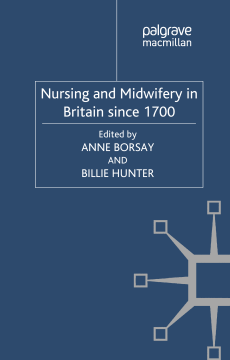
Additional Information
Book Details
Abstract
Nurses and midwives, both qualified and in training, have a lively interest in how their professions have developed. A stimulating collection of research-based essays, this book explores and compares the distinct histories of nursing and midwifery in Britain from the beginning of the eighteenth century to the modern day.
ANNE BORSAY is Professor of Healthcare and Medical Humanities in the College of Human and Health Sciences, Swansea University, UK.
BILLIE HUNTER is RCM Professor of Midwifery in the Cardiff School of Nursing and Midwifery Studies, Cardiff University, UK.
One of the many strengths of the book is that it focuses on nursing and midwifery, discussing the tensions between these professions and offering a balanced exploration of the similarities and differences between them.'
– Rachel Sales, Senior Lecturer in Nursing, University of the West of England, UK
'I would recommend this book to my undergraduate students as a way of putting their chosen profession in context. It is comparative, it covers major developments succinctly, and attempts to link historical features to contemporary issues and debate.' - Tania McIntosh, Lecturer in Midwifery, University of Nottingham, UK
Table of Contents
| Section Title | Page | Action | Price |
|---|---|---|---|
| Cover | Cove | ||
| Contents | v | ||
| Abbreviations | viii | ||
| Notes on Contributors | x | ||
| 1 Nursing and Midwifery: Historical Approaches | 1 | ||
| Origins | 2 | ||
| Histories | 4 | ||
| Doing History | 9 | ||
| Using This Book | 13 | ||
| PART I: NURSING 1700–2000 | 21 | ||
| 2 Nursing, 1700–1830: Families, Communities, Institutions | 23 | ||
| Domestic Nursing | 24 | ||
| Community Nursing | 26 | ||
| Institutional Nursing | 29 | ||
| Matrons and the Voluntary Hospital | 31 | ||
| Nurses and the Voluntary Hospital | 35 | ||
| Conclusion | 38 | ||
| 3 Nursing, 1830–1920: Forging a Profession | 46 | ||
| The ‘Pre-Reform’ Nurse | 46 | ||
| The Rise of Sisterhoods | 48 | ||
| The Influence of Florence Nightingale | 50 | ||
| The ‘New’ Nurse | 50 | ||
| The Poor Law Nurse | 54 | ||
| The District Nurse | 56 | ||
| The Military Nurse | 57 | ||
| The Professionalizing Project | 59 | ||
| The Path to Registration | 62 | ||
| Conclusion | 65 | ||
| 4 Nursing, 1920–2000: The Dilemmas of Professionalization | 74 | ||
| 1920–49: A Unified and Unitary Profession? | 76 | ||
| 1950–86: Professionalization, Nursing Hierarchies and Nurse Education | 81 | ||
| 1950–86: Obstacles to Professionalization | 87 | ||
| 1950–86: Professionalization and the Development of Nursing Research | 89 | ||
| 1986–2000: Professional Maturity, Education and Management | 92 | ||
| Conclusion | 97 | ||
| PART II: MIDWIFERY 1700–2000 | 105 | ||
| 5 Midwifery, 1700–1800: The Man-Midwife as Competitor | 107 | ||
| The Rise of the Man-Midwife | 108 | ||
| From Superstition to Science | 112 | ||
| Midwives and Men-Midwives | 117 | ||
| Conclusion | 121 | ||
| 6 Midwifery, 1800–1920: The Journey to Registration | 128 | ||
| In Whom ‘the community [has] the fullest confidence’: Midwives, 1800–60 | 129 | ||
| Towards Registration: Midwifery, 1860–1902 | 133 | ||
| Implementing the Midwives Acts, 1902–20 | 139 | ||
| Conclusion | 143 | ||
| 7 Midwifery, 1920–2000: The Reshaping of a Profession | 151 | ||
| The New Professional Midwife, 1920–37 | 152 | ||
| The Effects of the Second World War and the Formation of the NHS, 1948–74 | 156 | ||
| Post-1974: Competing Paradigms | 162 | ||
| Conclusion | 169 | ||
| PART III: COMPARING NURSINGAND MIDWIFERY | 175 | ||
| 8 International Comparisons: The Nursing–Midwifery Interface | 177 | ||
| Australia | 179 | ||
| United States | 184 | ||
| Canada | 190 | ||
| Comparing National Approaches to Nursing and Midwifery | 196 | ||
| 9 Nursing and Midwifery: An Uneasy Alliance or Natural Bedfellows? | 205 | ||
| Before the Registration Acts: Parallel Roles | 207 | ||
| Campaigns for Registration: Courting and Rebuffs | 209 | ||
| After the Registration Acts: Growing Allegiance | 211 | ||
| 1950–2000: Integration and Resistance | 213 | ||
| Discussion: An Uneasy Alliance or Natural Bedfellows? | 214 | ||
| Conclusion | 219 | ||
| 10 Epilogue: Contemporary Challenges | 224 | ||
| Recommended Further Reading | 230 | ||
| Index | 234 |
